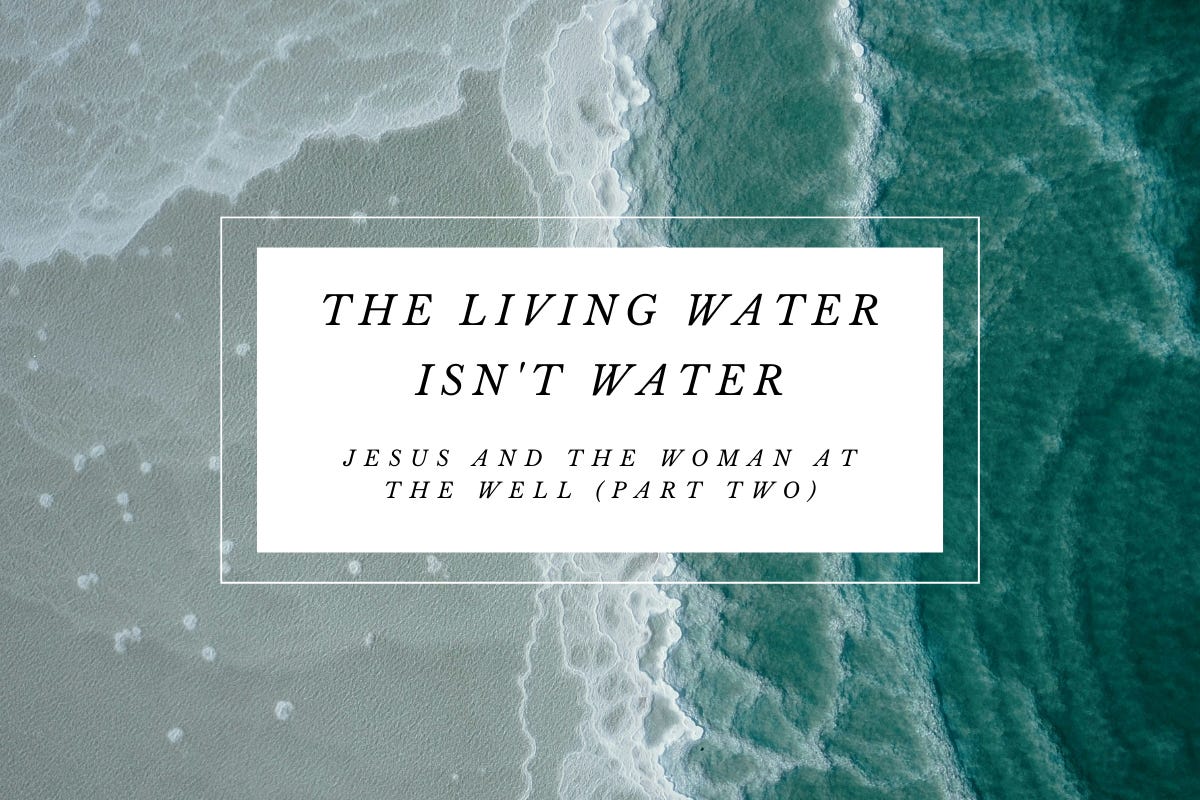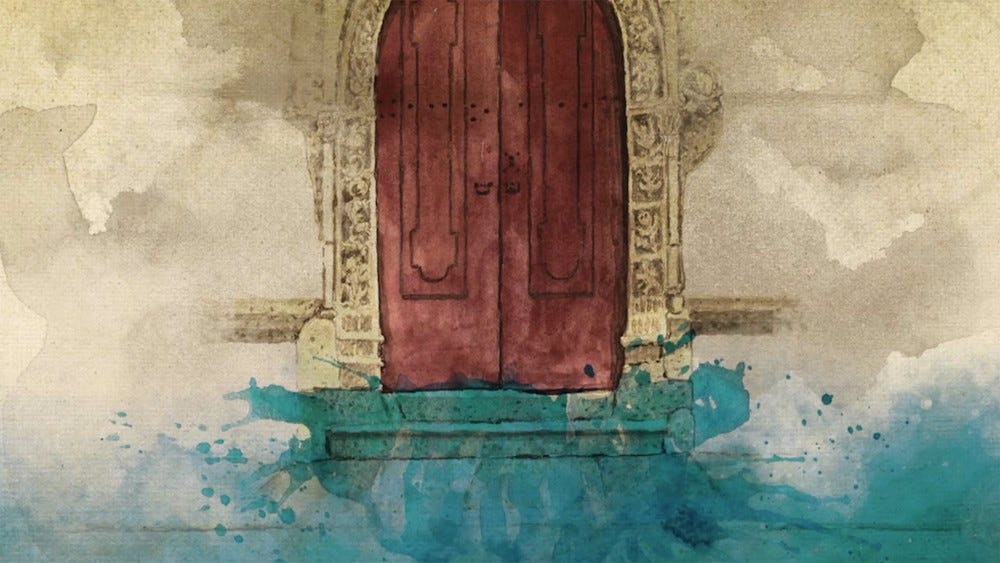The Living Water Isn't Water: Jesus and the Woman at the Well (Part Two)
If you are looking for a fountain to come shooting up out of the ground, you may be reading John 4 too literally.
This is the 11th part of our series examining the image of water in the Bible. Over the next months, we’ll be looking at these verses to follow the image of water as it flows from Genesis to Revelation.
We have looked at the biblical pattern of men in the Old Testament finding their wives at wells and also studied the way that pattern plays out in Jesus’ meeting with the Samaritan woman at the well in John 4. Now we will jump back into the conversation to examine the mysterious “living water” that Jesus says will make her live forever.
Jesus Introduces the Living Water
Remember where the conversation at the well started. Despite all the barriers between them, Jesus asked the Samaritan woman, “Would you give me a drink?”
She was surprised, to say the least, and answered him with a question, “How is it that you, a Jew, ask for a drink from me, a woman of Samaria?”
But Jesus pressed the point further. “If you knew the gift of God, and who it is that is saying to you, ‘Give me a drink,’ you would have asked him, and he would have given you living water.”
She challenged him again, saying, “The well is deep… besides, are you greater than Jacob?”
Then Jesus mysteriously alludes to a different sort of water. “Everyone who drinks of this water will be thirsty again. But not with my water… To drink my water is to live forever.”
Their verbal sparring continues until he tells her (more directly than anyone else in the gospels), “I am that messiah you hope for.” Suddenly, it is as if the conversation—and its climactic finale—have unlocked something in her. She runs back to her town, full of new life because of this stranger she is convinced is the one she has hoped for.
Readers might wonder: “What happened to all that talk about living water?” It is a good question because Jesus never gives her any water. Or does he?
If you are looking for a fountain to come shooting up out of the ground at the end of this conversation, you may be reading this story too literally.
The living water is water, but it also isn’t.
The Connections between the OT and NT
Before we explore that odd statement, let’s pause for a little refresher on “how to read the Bible 101.”
The Bible constantly references itself and interprets itself. It is not a grab bag of ancient documents that happen to have been collected together and venerated, they are part of a whole that references itself constantly. This “book of books” is a network of quotations, allusions, repeated actions, repeated phrases, events with striking similarities across time, and surprising reversals and ironies. In other words, patterns.
Events in the Bible are often connected in such a way that the one that is chronologically first signifies not only itself but the second which comes chronologically later, while the second involves and fulfills the first and even works backward in time and changes the meaning of the first event.
Meanings in the Bible are cumulative. As they unfold through the pages of scripture, ideas take on weight and meaning with each accumulated layer like a snowball rolling downhill. Or, in this case, a river flowing down a mountainside from a high, holy spring.
Here is a quote from Richard Hays’ Reading Backwards:
“It is as though the primary action of the Gospel is played out on center stage, in front of the floodlights, while a screen at the back of the stage displays a kaleidoscopic series of flickering images from Israel’s scripture… If the viewer pays careful attention, there are many moments when the words or gestures of the characters onstage mirror something of the shifting backdrop (or is it the other way around?).”
With all that in mind, we can ask the question: Where else does the concept of living water appear in the Bible?
What Other Things Does Water Come out of in the Bible?
I have always heard that the metaphor of “living water” simply refers to running water, contrasted with the still water of the well. But if you trace the image of running water back through the Bible, you can see there is a whole lot more to it.
Let’s try an exercise: What things are there in the Bible that water comes out of? Can you think of any fountains? Any springs? Is there any water coming from somewhere it isn’t supposed to come from?
Here are a few important ones.
Exodus 17: Water from the rock.
In Exodus 17, the Hebrew people have just crossed the sea in flight for their lives and now they are in the desert and they are afraid and desperate. They are angry at Moses and at God for bringing them there. They shout at him, “Give us something to drink.” God tells Moses to strike the rock with his staff and enough water will come out of it to satisfy the thirst of all the Israelites.
Paul writes of the Israelites at this moment that “...All drank the same spiritual drink. For they drank from the spiritual Rock that followed them, and the Rock was Christ.” (1 Corinthians 10: 4)
So here you begin to see what sort of connections John was bringing to the fore. In Exodus 17, water rushes out to satisfy the thirst of people in need—not to mention saving their lives. And, according to Paul, the source of the water is Christ himself.
Ezekiel 47: Water from the temple
There is also that time a river burst out of the door of the temple in Jerusalem.
The last 8 chapters of the book of Ezekiel are an architectural tour of Jerusalem guided by an angel. The angel takes Ezekiel all over Jerusalem and measures its dimensions, its gates, and the various rooms of the temple mount. As far as readability goes, it isn’t the most riveting section of the Bible.
As the tour goes on, you start to get these little hints that this isn’t just the normal temple mount. It has features beyond those of the normal physical place itself. Strange things start to happen, things with significance beyond themselves.
The angel takes Ezekiel to the door of the temple and he notices a trickle of water flowing out of the threshold. The trickle quickly becomes a torrent. The angel and the prophet follow the stream as it tumbles over the steps to the temple, out of the temple complex, down the temple mount, and through the streets of Jerusalem. First, it is ankle-deep, then knee-deep, waist-deep, then impassible.
They walk to the bank of the new river and in verse 47: 8 the angel says, “This river flows into the salty Dead Sea and it will make it fresh water…” and “Everywhere the river goes, everything will live.”
Remember that the Dead Sea is the lowest body of water on the planet. It is 10 times saltier than the ocean, which is why it is called the Dead Sea. It is almost completely devoid of life. But suddenly this temple river comes and transforms the salty water to fresh. The life force of the water is so potent that it is like it almost has resurrection power. Everywhere the river goes, everything will live.
It is living water.
But What Does It Mean?
Let’s pause here. What does it mean that a river of living water is flowing from the temple?
This is where you just sit with it for a long time. You think about the water. You think about other moments when the River of Life appears. You think about what altitude means in the Bible. You think about what else has been killed by salt and where that happened.
And you think about where this water is coming from, the temple.
The ancient temple had three sections inside it: the inner court, the holy place, and the most holy place. The most holy place was the epicenter of the temple, a place God had chosen in a special way to be the hotspot of his presence on earth. A giant purple curtain separated the holy place from the most holy place and only the high priest could enter and that only once a year. And this is where the water is coming from.
And, hey, speaking of Eden, didn’t it have three sections? And wasn’t there a river flowing out of the center? And wasn’t it at the top of a high mountain?
In fact, if you overlay the three-part description of Eden on Ezekiel 47, it looks like this:
The Living Water and Genesis 2
The image of the living water doesn’t start in Ezekiel 47 or Exodus 17, it goes further back to the first spring in the Bible.
“When no bush of the field was yet in the land and no small plant of the field had yet sprung up—for the Lord God had not caused it to rain on the land, and there was no man to work the ground, and a mist (OR SPRING, Andy’s addition) was going up from the land and was watering the whole face of the ground.” (Genesis 2:5)
As I’ve written before, Genesis 2 starts in a wasteland. Next, a spring rises and causes things to grow.
And verse 10 gives us a little more detail about this spring… the spring gathers into a river that rises in Eden (topographically higher than the garden) in the west and flows into the garden in the easternmost part before flowing down the mountain to the rest of the lands.
So this is where we meet the river of life, the fountain of living water. And it flows through the rest of the pages of the Bible, representing the life of God that is always on the move—moving out of, into, and through his people.
But how the water finds us—and what happens when it does—is different for each of us.
Which brings us back to the woman at the well.
Jesus Gives Her the Living Water
In a literal sense, Jesus doesn’t give her water. However, once we start looking through the lens of the trajectory of the biblical pattern of the river of life, we can see that he begins to give it to her as soon as she requests it.
Imagine him there. God incarnate is sweating in the heat of the sun, dust on his feet, waiting for a specific woman to come so that they could have an important conversation. Then she asks for a drink of his eternal water, saying, “Give me that water and I won’t have to come here and drink.” It is more of a deflection than a request. She is almost scoffing. But it is enough.
His next response seems like a non-sequitur until you see that he is beginning to administer the living water. He says, “Go call your husband.” For her, the water comes in the form of a challenge and a revelation.
You can imagine the scoffing smile falling from her face as she simply says, “I have no husband.”
Then he reveals that he has some special knowledge. “That’s right. You’ve had five husbands and the man you live with now is not your husband.”
He exposes something that is the scandal of her life, a weight she carries in society, a pain. What is he doing? How can he be so callous? He is pressing his finger to the exact place of her wounding. How will she respond? Outrage? Confession? Will she walk away? Fight back? No, she looks away. She pivots to theology.
“I can see you are a prophet… Tell me about this mountain. Samaritans worship at Gerizim. Jews at Jerusalem. What is the truth?”
He follows her there and inverts her paradigm. Given the two-option choice, he chooses neither. “God is looking for a different kind of worship and a different kind of worshipper and the time the new paradigm begins is now and here.”
She reveals her hope. “When messiah comes, he will answer all our questions.”
She has some points of confusion about her theology, but the core of it all is a hope she shares with the Jews: God has promised to send a messiah and we wait for him. He will save us.
Then comes the revelation. “I am the messiah.”
And in the elegance of the literary style of the gospels, that is all the insight you get about what happens inside of her that makes her transform.
The next moment, she is running back home, full of joy. The trickle of water that came from Jesus, the true temple, grows to a flood and sweeps her down into her town. She goes from house to house saying, “He told me all I ever did. Could this be the messiah?”
The Living Water Isn’t Water
What changed her? What form did the living water take in this instance?
On the one hand, it seems like a strange conversation that rushes toward an unaccountable climax after the two of them break through almost every social norm and barrier they can get their hands on. However, the brevity of the gospel account belies the profound transformation that occurs inside her.
To better understand what happened to her, let’s go back to the beginning of their encounter.
She is there because she doesn’t want to see people. She avoids the people of her town because they avoid her. But at the well, she meets a teacher who seems to be waiting for her, who knows her, who looks at her and addresses her with kindness.
She has suffered at the hands of men and been used by them, but here is a man who is pursuing her with a completely different intent. His whole bearing toward her is one of tenderness and dignity and he seems to be offering something to her. He teaches her gently who was confused and misinformed, one who society did not stoop to lead out of her confusion.
She has been rejected, but with him, she is sought after. He arranged this meeting alone by sending his disciples away, knowing that he could not have the conversation he wanted to have if she was surrounded by a group of Jewish men.
Her checkered past is an open secret in her village, the kind of thing everyone knows but no one talks about. He goes directly to the place of her greatest pain, not to shame her, but to woo her. He means to show her she is still safe, that she can still live.
And all of that softened her. As it would anyone, but there was something unique about this gracious confrontation. The softening became transformation the moment that she stepped inside the unbelievable belief that the person who was doing all this for her was the messiah himself.
And it as that fact dawns on her, that she transforms. The impact of his acceptance changes something in her.
She sees herself in a new light (how could she not) and that light is the utter acceptance—and more, the dogged pursuit—of her by the one who was sent by God to save the world.
That is why when she tells the story about him to the rest of her town, she doesn’t hide that he knows her most tender secrets. She shouts it from the rooftops. She says, “He told me everything I ever did!” I think we are to understand that she means every wrong thing I’ve done; those things you shamed me for. Because of this encounter, the place of her pain and wounding is the place her story now begins.
Suddenly, the outcast becomes a gatherer, the hardbitten and cynical woman is full of hope, the moral pariah becomes the discoverer of the messiah.
That is the water he gave her: to be seen and known by God himself. To be sought after and valued in his company. To have one’s broken story seen, comprehended, and mended.
That is the meaning of the living water. It is the life God gives in his Son.
Photo by artem belinsky on Unsplash










The overlay of the three part description of Eden on Ezekial 47 repeats itself in this very story:
Jesus ‐> the Samaritan woman -> the Samaritan village
And again:
Jesus-> His disciples -> all who have believed since His ministry began.
And again in His command to the disciples:
"You will be my witnesses in Jerusalem, and in Judea and Samaria and to the uttermost parts of the world"
I have enjoyed being exposed to the patterns in the Bible and now have more things to look for as I study. Thank you and all those whom you have mentioned for your diligent work.
Your thoughts are very meaningful to me and bring clarity to my thoughts. I want to tell you how beautiful your rendition of Psalm 23 is as well. You captured, better than David himself, the kind of shepherd Jesus truly is.